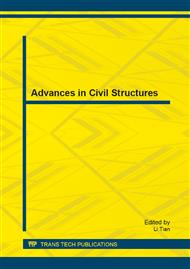p.630
p.637
p.641
p.645
p.650
p.654
p.658
p.663
p.667
The Effect of Confinement Method and Specimen End Condition on Behavior of FRP-Confined Concrete under Concentric Compression
Abstract:
This paper presents an experimental investigation on the influence of confinement method and specimen end condition on axial compressive behavior of fiber reinforced polymer (FRP)-confined concrete. A total of 12 aramid FRP (AFRP)-confined concrete specimens with circular cross-sections were tested. Half of these specimens were manufactured as concrete-filled FRP tubes (CFFTs) and the remaining half were FRP-wrapped concrete cylinders. The effect of specimen end condition was examined on both CFFTs and FRP-wrapped specimens. This parameter was selected to study the influence of loading the FRP jacket on the axial compressive behavior. In this paper the experimentally recorded stress-strain relationships are presented graphically and key experimental outcomes discussed. The results indicate that the performance of FRP-wrapped specimens is similar to that of CFFT specimens and the influence of specimen end condition is negligible.
Info:
Periodical:
Pages:
650-653
Citation:
Online since:
August 2013
Authors:
Price:
Сopyright:
© 2013 Trans Tech Publications Ltd. All Rights Reserved
Share:
Citation:


